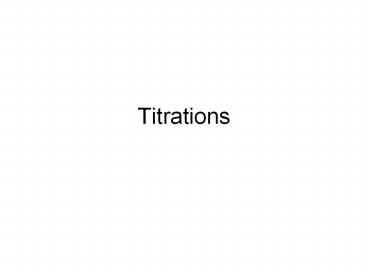Titrations - PowerPoint PPT Presentation
1 / 12
Title:
Titrations
Description:
Titrations Titration is a volumetric procedure for determining the concentration of an unknown species by adding a carefully measured volume of a known ... – PowerPoint PPT presentation
Number of Views:84
Avg rating:3.0/5.0
Title: Titrations
1
Titrations
2
- Titration is a volumetric procedure for
determining the concentration of an unknown
species by adding a carefully measured volume of
a known species that reacts with the unknown. - The equivalence point in a titration occurs when
the requirements of the balanced equation for
reaction are exactly satisfied. - An indicator is used to find the end-point pf
the titration. The end-point is the point where
the indicator changes colour. This may not be at
the equivalence point
3
(No Transcript)
4
- For an acid base titration the equivalence point
is the point where neutralisation occurs. - Indicators must have the following properties
- a) the color change must be sharp. i.e. the
indicator must change colour with the addition of
one drop of solution from the burette. - b) change colour as close to the equivalence
point as possible - c) Give a distinct colour change
5
(No Transcript)
6
Titration Curves
Strong Acid-Strong Base Titrations
The equivalence point of the titration is the
point at which exactly enough titrant has been
added to react with all of the substance being
titrated with no titrant left over. In other
words, at the equivalence point, the number of
moles of titrant added so far corresponds exactly
to the number of moles of substance being
titrated according to the reaction stoichiometry.
7
Titrations Involving a Weak Acid or Weak Base
- There are three major differences between this
curve (in blue) and the one we saw before (in
black) - 1. The weak-acid solution has a higher initial
pH. - 2. The pH rises more rapidly at the start, but
less rapidly near the equivalence point. - 3. The pH at the equivalence point does not equal
7.00. - POINT OF EMPHASIS The equivalence point for a
weak acid-strong base titration has a pH gt 7.00.
8
Weak Base / Strong Acid
1. The weak-base solution has a lower initial pH.
2. The pH drops more rapidly at the start, but
less rapidly near the equivalence point. 3. The
pH at the equivalence point does not equal 7.00.
POINT OF EMPHASIS The equivalence point for a
weak base-strong acid titration has a pH lt 7.00.
9
- Choosing an indicator
In the strong acid titration, both indicators
begin to change colour at the equivalence point
(50 mL of base) so both work equally well. In the
weak acid titration, thymol blue changes colour
at the equivalence point, but methyl red begins
to change colour after only 15mL of base are
added, which is far from the equivalence point,
illustrating the importance of choosing an
appropriate indicator.
10
Primary Standards A primary standard is a
reagent that is extremely pure, stable, has no
waters of hydration, and has a high molecular
weight. Some primary standards for titration of
acids sodium carbonate mol wt. 105.99
g/mol tris-(hydroxymethyl)aminomethane (TRIS or
THAM) mol wt. 121.14 g/mol Some primary
standards for titration of bases potassium
hydrogen phthalate (KHP) mol wt. 204.23 g/mol
potassium hydrogen iodate mol wt. 389.92
g/mol Some primary standards for redox
titrations potassium dichromate mol wt. 294.19
g/mol
11
- Secondary Standards
- A secondary standard is a standard that is
prepared in the laboratory for a specific
analysis. It is usually standardized against a
primary standard.
Some secondary standards for titration of
acids Sodium hydroxide Potassium hydroxide
12
- Standardisation Calculations
- Sodium carbonate (anhydrous) is used as a primary
standard. A solution of sodium carbonate of
concentration 0.100 mol/L is used to standardise
a solution of hydrochloric acid. 25.0 ml of the
standard solution requires 35 ml of the acid for
neutralisation. Find the concentration of the
acid.
Na2CO3 2HCl ? 2 NaCl
CO2 H2O
- 1 mole of Na2CO3 neutralises 2 moles of HCl
- No of moles of Na2CO3 in 25 ml 0.1 x 25
2.5 x 10 -3 mol -
1000 - No of moles HCl in 35 ml 2 x 2.5 x 10 -3 5.0
x 10 -3 mol - Conc of the acid 5.0 x 10 -3 x 1000 0.143
mol/L - 35































